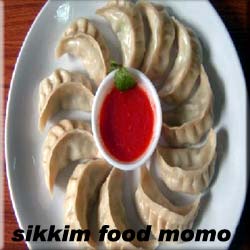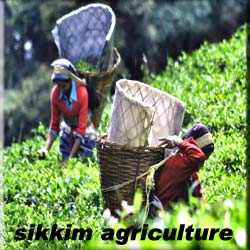CULTURE IS THE ART OF LIVING
The people of Sikkim are more commonly known as the Sikkimese. The prehistoric times of the state of Sikkim was occupied by three tribes namely Naong, Chang and the Mon. But however they were soon overtaken by the groups of people who were mainly from the neighboring country namely the Lepcha who belonged to the clan of Nagas. Soon Sikkim had three groups of major tribal people namely the Lepcha who migrated from Tibet, the Bhutias who are the descendants of Buddhists from Tibet and finally the Nepalese from Nepal and they are the descendants of Hindus.
The culture of SIKKIM can be best expressed as comprising the following : ORIGIN AND ETHNICITY
The Nepalese constitute the majority of the population of the people of Sikkim of about nearly 67% followed by the Bhutias of about 16% and then the Lepcha contributing 13% of the total population. The people of Sikkim are nature worshippers and peace loving and they still stick on to this feature. Nepali is the most common spoken language spoken by the people of Sikkim but other languages like Bhutia, Dzongkha, Groma, Gurung, Kafle, Lepcha, Limbu, Magar, Majhi, Majhwar, Nepal Bhasa, Rai, Sherpa, Sunuwar, Tamang, Thulung, Tibetan, and Yakha are also spoken by different groups of tribal people. The majority of the people living here in Sikkim are Hindus which is nearly 60.9% and Buddhism religion is followed by at least 28.1% of the population. The Lepcha tribes are mostly converted to Christians after the British missionaries who came during the 19th century.Due to majority of the population having been migrated into the state from the neighboring country Nepal, the people of Sikkim are more of Nepali ethnic in origin. It was the Lepchas group of people who were the original occupants of the state even before the entry of the Bhutias and the Nepalese. The Lepchas live in the central part of Sikkim and they speak the tribal language 'lepcha' which is not very common among other groups of people. They are very good at archery. The northern part of Sikkim is mostly occupied by the Bhutias who migrated from Tibet during the late 15th century. Sikkim has its religion incorporated with Bhutias. The Sikkimese language is spoken by the Bhutias. It was much later after the entry of the Lepchas and the Bhutias, the Nepalese came into the state and now they form the most dominant community in the state. The Nepalese are sub-divided into various castes and tribes like Bawans (Brahmans), Chhetries, Gurungs, Tamangs, Rais, Limbus, Magars, Damais, Kamis, etc. The majority of the Nepalese who migrated to Sikkim follow the religion of Hinduism. Some of the other migrant resident communities dwelling in South Sikkim and Gangtok are the Biharis, Bengalis and Marwaris.
CULTURE
The people of Sikkim have a rich cultural heritage with a homogenous blend of different religion, customs and traditions of different communities of people living. Apart from the traditional Sikkimese language and the tribal languages the people of Sikkim also speak other languages like Hindi and English. They are generally characterized as warm and friendly in nature for even in spite of different communities occupying the state they still live in peace and harmony. Even small festivals are celebrated with great enthusiasm and devotion. There are social or religious gatherings or celebrations which cannot miss out the music and dance of the people of Sikkim.
The mask dance is very famous here and is performed by the monks in the temple during religious festivals. The monks cover themselves with gaily-painted masks, ceremonial swords and sparkling jewels where they dance according to the sound of resounding drums, trumpeting horns and religious chanting. The earliest inhabitants of the state namely the Lepchas are predominantly Buddhist and Christians, but however before the introduction of these two religions they believed in the bone faith or mune faith based on the spirits, good and bad for they prayed to the spirits associated with nature like mountains, rivers and forests. Their settlements are quite small for each hut in a village is made of bamboo and is raised about five feet above the ground on stilts. There are just a couple of rooms with only small minimum essential requirements of life.
CUSTOMS AND TRADITIONS
On any religious festival and occasions the monks of the temple cover themselves with masks, ceremonial swords and sparkling jewels dance according to the rhythm of resounding drum and trumpeting of horns. The people of Sikkim who follow the Mahayana form of Buddhism celebrate the festival of Saga Dawa which is supposed to very auspicious. On this particular day the people go the monasteries and worship offering butter lamps. There are also processions arranged by the monks and they go around the town of Gangtok reading and singing the Holy Scriptures. As a matter of offering thanks to Mount Kanchendzonga which is considered to guard the state of Sikkim, the festival of Phang Lhabsol is celebrated with great pomp. Kagyat dance is performed every 28th and 29th day of the Tibetan calendar. The solemn nature of the dances is interspersed with comic relief provided by the jesters. The people of Sikkim especially the Hindu-Nepali celebrate the Dasian festival in the months of September - October which mainly symbolizes the victory of good over evil. Some of the common festivals celebrated by the people living here are Saga Dawa, Losoong, Namsoong, Labab Duchen, Kagyat dance, Yuma- Sam-Manghim, Tendong-lho-Rum- Fat, etc. According to their tradition the festival of lights, Diwali is celebrated on the 10th day after Dasain. The married females of the Bhutia community tie a piece of stripped cloth around their waist called Pangden signifying their marital status. FAMOUS FOR
The Sikkimese are known for their traditional sport of archery which is played especially after the harvest. This is one of the ancient sports practiced by the people rejuvenating the cultural identity of the region. The players cannot play the sport wearing normal dresses but they will have to dress up with their traditional attire named kho.A small wooden target measuring 3 by1 feet lying at a distance of 130 meters is to be shot. During the sport the opponents in order to confuse the player, wreak verbal abuse on them. The women of the Bhutia community also participate where they use vulgar insinuations at the opponent archers that even the most rational and pragmatic people also start blushing. This is considered more often as a fun. In some villages, a ritual of burying the effigies of the opponents is also practiced as that is believed as an inflictor of bad luck to the opponent.COSTUMES
The men belonging to the Lepcha community wear a white pajama, stretching to the calves and this is called as Thokro-Dum. The men wear a shirt and a cap commonly known as Yenthatse and Shambo respectively. The costume of Bhutia men is similar to that of the Lepcha which is known as Bakhu which is like a long robe and tied to the neck on one side and with a silk or a cotton belt at the waist. On top of all this they prefer a waist coat, Jya Jya. Nepalese constitute a portion of the population of the people of Sikkim and their origin is very clearly depicted in their attires. The Nepalese men dress themselves in Shurval, a Churidar Pajama, topped off by a shirt, known as Daura. The women of Lepcha community drape themselves with a smooth and cozy dress which is quite long and goes up to the ankle. The blouse worn by them is very loose and is known as Tago. Apart from this they wear a belt and a cap and adorn themselves with earrings, called Namchok, Lyak a necklace, Gyar and a bracelet. The costume of the Bhutia women is more or less similar to that of the Lepcha's. The married women of this community apart from their regular costume wear a stripy apron known as Pangden.They are quite crazy about gold ornaments. The women belonging to the Nepali community adorn themselves with vibrant colours especially the saris. The blouse is loose and is fastened from four sides and hence is called Chaubandi Cholo.The upper portion of the body is daintily enveloped with a piece of cloth with wonderful prints. It is called Hembari. CUISINE

OCCUPATION

FAMOUS PERSONALITIES
Balmiki Prasad Singh -present governor of Sikkim, India. He is a distinguished scholar, thinker and public servant and has written several books.Akansha Juneja -Small screen actress seen in various serials like Mahayatra, Thoda Hai Bas Thode Ki Zaroorrat Hai and Hamaari beti.
Baichung Bhutia -Indian footballer and is considered to be the torchbearer of Indian football in the international arena. He is often nicknamed the Sikkimese Sniper because of his shooting skills in football.
Danny Denzongpaan - Indian actor working in Bollywood films. He is of Sikkimese ancestry. Denzongpa was born in the state of Sikkim, at that time an independent monarchy.


